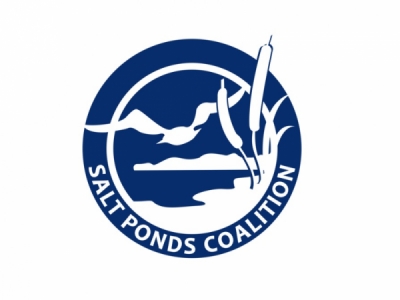
Posted on February 4, 2019
CHARLESTOWN — Confronted with a shortfall on the Quonochontaug Pond Marsh Restoration Project, members of the Salt Ponds Coalition quickly raised $347,500 to complete the work. Coalition President Art Ganz presented a check Thursday to the Rhode Island Coastal Resources Management Council, the agency leading the initiative.
CRMC Policy Analyst Caitlin Chaffee, who accepted the donation, said, “The project would not have been possible without the support of the town and the local community.”
“In particular, the Town of Charlestown, the Salt Ponds Coalition and the Shelter Harbor Conservancy provided us with the majority of the non-federal match that we needed to secure our federal funds and complete the project as originally designed,” Chaffee said. “This has truly been a collaborative effort among federal, state and local entities to preserve and enhance this important resource.”
The objective of the restoration was to dredge the breachway, thereby improving the flow of water and the water quality of the pond. The dredged sediment was used to build up the salt marsh, which has been subsiding — effectively drowning in place.
The work began in mid-December and was completed ahead of schedule.
A federal Coastal Resilience grant from the National Oceanic and Atmospheric Administration provided $980,000, and the towns of Westerly and Charlestown, the Shelter Harbor Conservation Society, and the Charlestown-based Salt Ponds Coalition contributed additional funds. Other partners in the project are the U.S. Fish and Wildlife Service, the Rhode Island Department of Environmental Management, and Save The Bay.
The Salt Ponds Coalition is an environmental nonprofit environmental group dedicated to protecting the health of the state’s southern coastal salt ponds. Coalition Vice President Richard Sartor said the partners in the project had raised money based on an expected cost of $1.3 million.
“There were federal grants and a little bit of state money and the Town of Charlestown agreed to put in $250,000 that made up the $1.3 million that was the anticipated amount that was going to be necessary,” he said.
Then came the news in December that the bids on the project were much higher than expected. The reason, Sartor said, was that the work was more complex than a simple dredging operation.
“The lowest qualified bidder was about $2.1 million, about a $800,000 shortfall,” he said. “The reason is the marshland restoration. All that extra work with specialized equipment. There were only a couple of companies in the country that could do that, so it was pricey.”
When the CRMC learned of the shortfall, it initially suggested that the project be scaled back.
“That was not something that many of the people in the communities, Weekapaug, Charlestown, wanted to see and they were beginning to talk about the effort to raise the funds to have full build,” Sartor said.
The CRMC managed to obtain an additional $200,000 in federal funding and Charlestown contributed another $200,000. That left about $400,000 still to raise.
In late December, private organizations and individuals from Charlestown and Westerly stepped up, and in just a few weeks raised $350,000. The Salt Ponds Coalition coordinated the fundraising effort, which included the Weekapaug Foundation for Conservation, the Weekapaug Yacht Club, the Shelter Harbor Fire District, the Ocean House Marina, the Weekapaug Inn and the Westerly Yacht Club. Several individual donors also contributed.
“The thing is, the tremendous outpouring of support created the capability for this project to be completed fully, rather than to be severely restricted,” Sartor said. “What it would have meant is the western channel, the one that leads down toward the Weekapaug section of Quonochontaug, would not have been completed at the level that it is. It would have been curtailed significantly, and that, we felt, was very important to the flow of the water … By removing that sand and building up the marshlands, the habitat that exists there is all going to be protected and preserved as well.”
With the dredging and grading done, Save The Bay has begun fencing off the newly built-up areas to prevent sediment from washing away before it can be planted in the spring.
David Prescott, South County coast keeper for Save The Bay, said his group had learned a lot from a previous restoration project on Ninigret Pond.
“Our plans have been and always were to learn from the Ninigret project and apply those lessons to Quonnie,” he said. “So what we were doing the other day was basically installing fencing to help control some of the sand transport. One of the pieces that we never really considered with the Ninigret project was how fast that sand would move if it was windy, so we’re trying to get a jump on that.”
Prescott explained that there are two restoration sites, a large section on the east side of the breachway and a smaller, heavily-used spit of sand on the west side of the breachway.
“The pre-existing spit right there on the northeast corner of the DEM parking lot, over the years, it’s seen a lot of intensive use,” Prescott said. “There’s a lot of people using that spit and there’s issues with boat wake as well. That section of the spit was enhanced as a recreational benefit.”
When the weather warms, the DEM will bring in its low-impact excavator to dig drainage channels in the marsh. Save The Bay will also begin planting the restored areas, which in turn will stabilize them.
“In early March, our plan is to start some of the planting with the major salt marsh planting happening further in the spring,” Prescott said.
Source: The Westerly Sun





